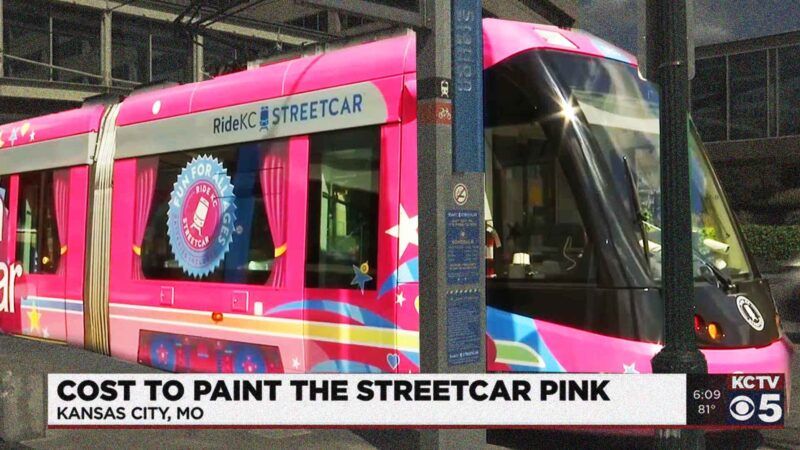Kansas City Made a Barbie-Themed Streetcar. It Cost Taxpayers $25,000.
Officials say that the "Dream Streetcar" is intended to boost ridership, even though the streetcar is free.

Kansas City, Missouri, unveiled a Barbie-themed streetcar, dubbed the "Dream Streetcar" earlier this month. The streetcar is decked out in familiar bubblegum-pink wrapping and even rewrites the city's name as "Kensas City." A lucky passenger can even choose a seat decked out to resemble characters from the recent Barbie film, like "Stereotypical Barbie, President Barbie, Cowboy Ken, and even Allan."
Oh, and the whole thing cost taxpayers $25,000.
According to records obtained by KCUR, Kansas City's NPR affiliate, the hefty public spending is due to the fact that the Dream Streetcar is not actually a sponsored ad for the blockbuster Barbie movie that premiered in July. Instead, it's a project by the Kansas City Streetcar Authority (KCSA) to increase ridership, even though the streetcar is free to ride.
The streetcar is funded by a special tax levied on property owners in a "Transportation Development District" near the streetcar's path, as well as a 1 percent sales tax on purchases made in the area.
The KCSA denies that the Dream Streetcar is explicitly Barbie-themed. "The Dream Streetcar does not utilize any Barbie or Mattel branding or images. It does not even display the Barbie name," Donna Mandelbaum, the KCSA's communications and marketing director tells Reason. "This streetcar wrap was not intended to promote a movie or a brand but it is intended to bring a positive experience for our riders, our community, and to downtown KC."
However, it's difficult to view the Dream Streetcar as anything but Barbie-themed, especially considering multiple references to the film in the press release announcing the decorated car.
https://twitter.com/Beertheist/status/1698867685214347625
"KC Streetcar marketing efforts have goals to increase streetcar ridership, promote the Ride KC Streetcar brand…and showcase that public transit can be both essential and fun," Mandelbaum tells Reason. "We have a marketing budget to do such things."
According to KCUR, ridership did tick up in the days following the Barbie streetcar's debut, although those days coincided with Labor Day weekend and a popular summer festival in Kansas City. After Labor Day weekend, streetcar ridership returned to average levels.
Besides that the Dream Streetcar hasn't so far achieved its stated goals, the streetcar system itself is also incredibly expensive and inefficient.
For starters, the streetcar just isn't a very useful piece of public transportation. "The streetcar project has all the appearances in Kansas City of a theme park–style development," Patrick Ishmael, the director of government accountability at the Show-Me Institute in St. Louis, tells Reason. "The capacity, the speed, the purpose of the project is hardly different than what you'd see at Disney World. And…it's actually oftentimes faster to walk than to use the streetcar."
The project has also been incredibly expensive for taxpayers—according to the streetcar's own website, the two-mile-long line cost over $100 million to design and build.
Further, the free streetcar isn't even directly responsible for economic growth along the streetcar line. "It is not the streetcar that is driving economic development," Patrick Tuohey, the co-founder and policy director of the Better Cities Project, which researches economic development and transportation policy, tells Reason. "It is all the economic development subsidies along the streetcar line that encourage people to develop along that spot."
So not only is the streetcar not very good at actually getting people where they need to go, it unsurprisingly isn't directly helping local businesses either. Plus, those local businesses now face higher taxes to pay for the streetcar's construction and operating costs.
"Most of the time in successful urban environments, hotels and entertainment districts… and transit—like streetcars—are a sign of a thriving economy," Touhey adds. "Rather than understanding that development is a sign of a healthy economy, they think if they subsidize development, it will result in a healthy economy, so they get it exactly backward. And so the streetcar…[is] a very thin veneer wrapped around the city that creates the illusion of economic success."

Show Comments (38)